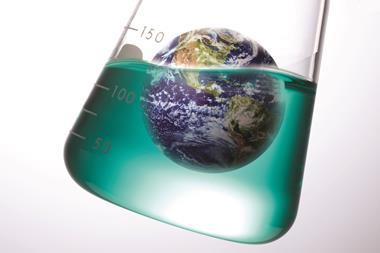Breaking the Sabatier limit central to unconventional approach for optimising reactions
Advances in a concept called catalytic resonance theory could help chemists create heterogeneous catalysts that can overcome selectivity issues plaguing chemical manufacturing. Researchers in the US had previously used computational models to show that oscillating waves matched to the frequency of chemical transformations, such as adsorption and desorption, should be able to accelerate a reaction beyond what was previously possible. Now, they’ve theorised that the same concept can be used to selectively generate a particular product.1
Catalysts are designed to balance out rate limitations in the slowest reaction steps. Traditionally, this design process involves modifying active sites, nanostructuring or using particular crystallographic surfaces, and will follow the Sabatier principle developed by French chemist Paul Sabatier to describe heterogeneous catalytic reactions.
The Sabatier principle states that the interaction between a catalytic surface and its substrate needs to be finely tuned for the catalyst to be effective – if the interaction is too strong then the product will get stuck, too weak and the reactants dissociate before the catalytic pathway can proceed. ‘Catalysts are designed to balance out the rate limitations of two or more slow steps,’ explains Paul Dauenhauer, from the University of Minnesota in the US. ‘The best possible catalysts exactly balance out these rate limitations, but this means that there is a theoretical limit to catalyst performance. It is not possible to make static catalysts faster than the Sabatier limit.’
There have been previous attempts to design catalysts that bypass the Sabatier limit. ‘A two-catalyst approach has been tried for a long time, and it hasn’t been successful, probably because it still has the same problem; there is an energy penalty to move between catalytic sites,’ says Dauenhauer.
This led Dauenhauer to hypothesise a catalyst that could switch characteristics – a catalyst where there was one reaction site that changed with time. From this idea, Dauenhauer and his colleagues have developed catalytic resonance theory as a new way to understand and potentially control turnover and selectivity in heterogeneous catalysis.
This opens up an exciting new set of parameters for which catalysts might be optimised
Catalytic resonance theory exploits the transient behaviours of adsorption and desorption, and the reactions that occur on the catalyst surface. Overtime, surface binding energy and transition state energies oscillate. At a certain point, it may be easier for a reactant to bind, or a product to leave.
‘Some reactions exhibit major changes in surface energy as the electronic state of a catalyst varies, while other reactions only minimally vary. These differences can be exploited by selecting the dynamic parameters that account for the reaction of interest,’ explains Dauenhauer.
On applying an external wave at the catalyst surface that resonates with these oscillations, the team found they could drastically accelerate a reaction by carefully tuning the amplitude and frequency of the wave.
‘The proposed concept is innovative and fascinating,’ remarks Gloria Berlier from the University of Turin, Italy, who works on the catalysis of surfaces.
Dynamic catalysts
Simulations from Dauenhauer’s team show that it is possible to apply the resonant waves in such a way that makes reactions almost completely selective, even for products that would normally be disfavoured. They also predict that oscillating waves will be able to tune multiple parallel reaction systems with a broad range of chemical parameters through influencing the thermodynamics and kinetics.
‘According to catalytic resonance theory, auxiliary driving forces can be used not only to drive reactions but also to optimise the efficiency and specificity of catalysts. This opens up an exciting new set of parameters for which catalysts might be optimised,’ comments Sandra Luber, an expert in theoretical chemistry and materials science at the University of Zurich in Switzerland.
However, Luber adds that ‘experimental validation would be desirable’. And Berlier says she is ‘looking forward to witnessing experimental validation of the concept in industrially relevant reactions, such as alkene oligomerisation or the direct methane to methanol dream reaction.’
This relevance to industry is not lost on Dauenhauer who says ‘it is our goal to develop these technologies for industry where they will have significant impact. There are many mature industrial processes where catalyst selectivity has been stuck at only 60–80% for decades. These systems are opportunities for an entirely different approach to catalyst implementation.’
Dauenhauer’s team is already exploring the practicalities of catalytic resonance theory. In fact, they have just posted the first experimental verification of catalytic resonance theory extending a reaction beyond the Sabatier speed limit on ChemRxiv.2
References
1 M A Ardagh et al, Chem. Sci., 2020, DOI: 10.1039/c9sc06140a (This article is open access.)
2 J Gopeesingh et al, ChemRxiv, 2020, DOI: 10.26434/chemrxiv.11972031.v1












No comments yet